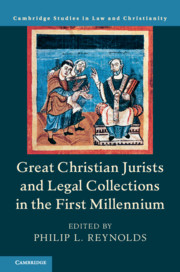Book contents
- Great Christian Jurists and Legal Collections in the First Millennium
- Law and Christianity
- Great Christian Jurists and Legal Collections in the First Millennium
- Copyright page
- Contents
- Contributors
- Preface and Acknowledgments
- Abbreviations
- Part I
- Part II
- 10 Lactantius
- 11 Ambrosiaster
- 12 Augustine of Hippo
- 13 Leo the Great
- 14 Gelasius I
- 15 Dionysius Exiguus
- 16 Benedict’s Rule
- 17 Gregory the Great
- 18 Isidore of Seville
- 19 Pseudo-Isidorus Mercator
- 20 Jonas of Orléans
- 21 Hincmar of Reims
- 22 Regino of Prüm
- 23 Burchard of Worms
- 24 New Horizons in Church Law
- Index
24 - New Horizons in Church Law
from Part II
Published online by Cambridge University Press: 21 June 2019
- Great Christian Jurists and Legal Collections in the First Millennium
- Law and Christianity
- Great Christian Jurists and Legal Collections in the First Millennium
- Copyright page
- Contents
- Contributors
- Preface and Acknowledgments
- Abbreviations
- Part I
- Part II
- 10 Lactantius
- 11 Ambrosiaster
- 12 Augustine of Hippo
- 13 Leo the Great
- 14 Gelasius I
- 15 Dionysius Exiguus
- 16 Benedict’s Rule
- 17 Gregory the Great
- 18 Isidore of Seville
- 19 Pseudo-Isidorus Mercator
- 20 Jonas of Orléans
- 21 Hincmar of Reims
- 22 Regino of Prüm
- 23 Burchard of Worms
- 24 New Horizons in Church Law
- Index
Summary
This final chapter expands the “millennium” into the early twelfth century, sketching pivotal historical/legal developments that had profound impact for church law. These include the transmission of important early canonical collections such as the ninth-century Pseudo-Isidorian Decretals; the rise to prominence of the Reform papacy in the pontificate of Leo IX (1049–54) as a source of law via papal letters and decrees of church councils; and the compilation of new canonical collections that blended recent legislation with traditional texts. In addition, the late eleventh-century rediscovery of the Digest of Justinian, a work assembled in the sixth century, provided investigators c. 1100 with a vast reservoir of legal ideas from antiquity. The complicated task of trying to blend these diverse materials into a coherent, noncontradictory corpus posed a hermeneutical challenge that was taken up by writers such as Alger of Liège, Bernold of Constance, and especially bishop Ivo of Chartres. Their resulting works opened a window on “new horizons” and paved the way by the middle of the twelfth century for the great textbooks of scholastic method in church law and theology, assembled respectively by Gratian, and Peter Lombard.
Keywords
- Type
- Chapter
- Information
- Publisher: Cambridge University PressPrint publication year: 2019

